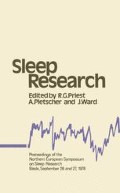Abstract
Numerous experimental results, obtained in the last 10 years, have indicated that brain catecholaminergic systems are involved in the regulation of wakefulness and sleep. The investigation of the wakefulness mechanisms has given rather unambiguous results, pointing to a role of ascending neuronal systems containing norepinephrine (NE). Selective lesions of these systems by microinjection of 6-hydroxydopamine (6-OHDA), a drug inducing neurotoxic lesions of catecholamine (CA) neurons, result in a decrease of EEG waking, most pronounced during the first 4 days after the lesion, and followed by a gradual recovery11. Similarly, the administration of alpha-methylparatyrosine (αMPT), an inhibitor of CA synthesis through blockade of tyrosine hydroxylase, induces in animals a decrease of wakefulness, which can be temporarily reversed by microinjections of NE in the preoptic area or in the reticular activating systems19. These and other results indicate that an enhancement of activity in NE synapses induces EEG waking, whereas dopaminergic (DA) systems may be more specifically involved in behavioural wakefulness3.
Access this chapter
Tax calculation will be finalised at checkout
Purchases are for personal use only
Preview
Unable to display preview. Download preview PDF.
References
Gaillard, J.-M. and Kafi, S. (1979). Involvement of pre- and postsynaptic receptors in catecholaminergic control of paradoxical sleep in man. Eur. J. Clin. Pharmacol. (In press)
Hartmann, E., Chung, R., Draskoczy, P. R. and Schildkraut, J. J. (1971). Effects of 6-hydroxy-dopamine on sleep in the rat. Nature (London)., 233., 425
Jouvet, M. (1969). Biogenic amines and the states of sleep. Science., 163., 32
Kafi, S., Bouras, C., Constantinidis, J. and Gaillard, J.-M. (1977). Paradoxical sleep and brain catecholamines in the rat after single and repeated administration of alpha-methyl-paratyrosine. Brain Res., 135., 123–134
Kafi, S. and Gaillard, J.-M. (1978). Biphasic effect of chlorpromazine on rat paradoxical sleep: a study of dose-related mechanisms. Eur. J. Clin. Pharmacol., 49., 251
Kales, A., Ansel, R. D., Markham, C. H., Scharf, M. B. and Tjiauw-Ling Tan (1971). Sleep in patients with Parkinson’s disease and normal subjects prior to and following levodopa administration. Clin. Pharmacol. Ther., 12., 397
Kendel, K., Beck, U., Wita, C., Hohneck, E. and Zimmermann, H. (1972). Der Einfluss von L-dopa auf den Nachtschlaf bei Patienten mit Parkinson-Syndrom. Arch. Psychiatr. Nervenkr., 216., 82
King, C. D. and Jewett, R. (1971). The effects of alpha-methyl-tyrosine on sleep and brain norepinephrine in cats. J. Pharmacol. Exp. Ther., 177., 188
Laguzzi, R., Petitjean, F., Pujol, J. F. and Jouvet, M. (1972). Effets de l’injection intraventriculaire de 6-hydroxy-dopamine. II. Sur le cycle veille-sommeil du chat. Brain Res., 48., 295–310
Leygonie, F., Thomas, J., Degos, J. D., Bouchareine, A. and Barbizet, J. (1976). Troubles du sommeil dans la maladie de Steele-Richardson. Etude polygraphique de 3 cas. Rev. Neurol., 132., 125
Lidbrink, P. (1974). The effect of lesions of ascending noradrenaline pathways on sleep and waking in the rat. Brain Res., 74., 19–40
Matsumaya, S., Coindet, J. and Mouret, J. (1973). 6-Hydroxydopamine intra-cisternale et sommeil chez le rat. Brain Res., 57., 85–95
Matsumoto, J. and Jouvet, M. (1964). Effets de réserpine, DOPA et 5-HT sur les deux états de sommeil. C. R. Soc. Biol., 158., 2137
Pujol, J. F., Kan, J. P., Buda, M., Petitjean, F., Mouret, J. and Jouvet, M. (1975). Is 6-hydroxy-dopamine (6-OHDA) a specific tool for the study of functional roles of catecholaminergic (CA) neurons in the sleep-waking cycle? In G. Johnson, T. Malmfors and C. Sachs (eds.), Chemical Tools in Catecholamine Research., Vol. I, pp. 259–266. (Amsterdam: North-Holland Publishing Company)
Sitaram, N., Moore, A. N. and Gillin, J. C. (1978). Induction and resetting of REM sleep rhythm in normal man by arecholine: blockade by scopolamine. Sleep., 1., 83
Stern, W. C. and Morgane, P.J. (1973). Effects of alpha-methyl-tyrosine on REM sleep and brain amine levels in the cat. Biol. Psychiatry., 6., 301
Stern, W. C. and Morgane, P.J. (1973). Effects of reserpine on sleep and brain biogenic amine levels in the cat. Psychopharmacologia (Berlin)., 28., 275–286
Svensson, T. H., Bunney, B. S. and Aghajanian, G. K. (1975). Inhibition of both noradrenergic and serotonergic neurons in brain by the α.-adrenergic agonist Clonidine. Brain Res., 92., 291–306
Torda, C. (1968). Effect of changes of brain norepinephrine content on sleep cycle in rat. Brain Res., 10., 200–207
Weitzman, E. D., McGregor, P., Moore, C. and Jacoby, J. (1969). The effect of alpha-methyl-para-tyrosine on sleep patterns of the monkey. Life Sci., 8., 751
Wyatt, R.J. (1972). The serotonin-catecholamine-dream bicycle: a clinical study. Biol. Psychiatry., 5., 33
Editor information
Editors and Affiliations
Rights and permissions
Copyright information
© 1979 MTP Press Limited
About this chapter
Cite this chapter
Gaillard, JM. (1979). Brain Catecholaminergic Activity in Relation to Sleep. In: Priest, R.G., Pletscher, A., Ward, J. (eds) Sleep Research. Springer, Dordrecht. https://doi.org/10.1007/978-94-011-6226-5_4
Download citation
DOI: https://doi.org/10.1007/978-94-011-6226-5_4
Publisher Name: Springer, Dordrecht
Print ISBN: 978-94-011-6228-9
Online ISBN: 978-94-011-6226-5
eBook Packages: Springer Book Archive

